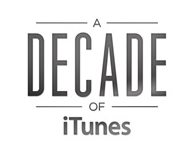 On the 10th anniversary of the iTunes Music Store, we thought it would be fun to turn back the clock and take a look at how we covered Steve Jobs’ introduction of the service. The event also introduced iTunes version 4 and the third generation iPods, with what turned out to be a short-lived redesign and a capacity of up to 30GB — “up to 7,500 CD-quality songs,” according to Jobs, in an analogy that might not have much meaning for today’s music buyers.
On the 10th anniversary of the iTunes Music Store, we thought it would be fun to turn back the clock and take a look at how we covered Steve Jobs’ introduction of the service. The event also introduced iTunes version 4 and the third generation iPods, with what turned out to be a short-lived redesign and a capacity of up to 30GB — “up to 7,500 CD-quality songs,” according to Jobs, in an analogy that might not have much meaning for today’s music buyers.
Read on for our “as-it-happened-coverage” of the birth of a music industry sea change.
Apple Music Event coverage: Online music service, new iPods, iTunes 4
Monday, April 28, 2003
by Chuck La TournousTelling an audience of reporters that Apple’s purpose is to “innovate,” CEO Steve Jobs introduced the “third generation” of Apple’s iPod audio players in 10GB, 15GB and 30GB models. The 30GB model will hold up to 7,500 CD-quality songs, Jobs said.
He also announced the immediate availability of iTunes 4 and the “iTunes Music Store” for Mac users. Jobs said the service will be compatible with Windows computers by the end of the year.
The new iPods are lighter, thinner and curvier than previous models. Control buttons have been moved from their position surrounding the control wheel and now sit as small circular buttons above it. The new models support both Mac and Windows out of the same box and the two higher-end models ship with a case and a dock complete with connectors for home stereo systems, as well as a USB 2.0 jack for Windows users. The new iPods are due in “large supply” by Friday, Jobs said and are priced at $299, $399 and $499.
Jobs also announced iTunes 4, which provides software support for AAC encoding, which he said sounds “a lot better” than MP3. iTunes 4 will also support Apple’s Rendezvous networking and streaming via TCP/IP. Streams played from other Macs cannot be saved, which Jobs called “verboten.” He said “you can listen to others’ music when they’re around,” sure to please the recording industry, which has repeatedly objected to features that make it easy for listeners to copy music for others.
The application also allows for DVD archiving and advanced features like displaying album covers which can be obtained with songs purchased through its new online music store (see below).
Jobs told the audience that although Napster “showed us that the Internet was made for digital music delivery,” it had many drawbacks: unreliable downloads, unreliable encoding, no cover art. “And, it’s stealing,” he said.
Subscription services like Rhapsody and pressplay are not the answer, either, Jobs said. “People have always bought their music,” noting that Apple had been working on its music store for over a year.
Apple’s new service requires no subscription and offers songs from all five major music labels for 99 cents each, with complete albums available at discounted prices — typically around $9.99). Jobs said there are over 200,000 songs immediately available.
The service allows unlimited CD burning for personal use, but a single playlist can only be copied 10 times before it must be modified. Downloaded music can be played on up to three Macs and an unlimited number of iPods. Purchased songs can be used within Apple’s other “iLife” applications, like iMovie and iDVD.
Each song is “pristinely encoded” in 128-bit AAC format and Jobs said some sound “better than CDs.” There is a free 30-second preview available for every song in the service.
Jobs said the service will feature one-click ordering and will be easily browsable — via iTunes — by artist, genre and album, and displays warning labels for songs with explicit lyrics. It will also offer tracks not available anywhere else, he said.
The new service, dubbed “iTunes Music Store,” requires the free iTunes 4 update. Existing iPods will also be able to use the new service with free version 1.3 software upgrade. Both updaters are available now.